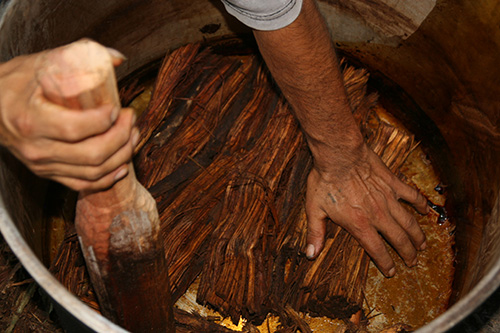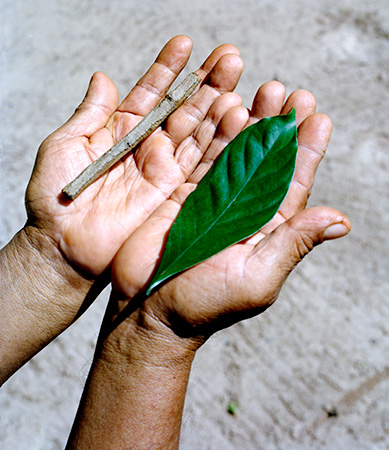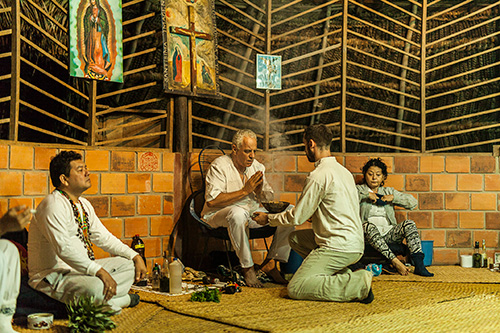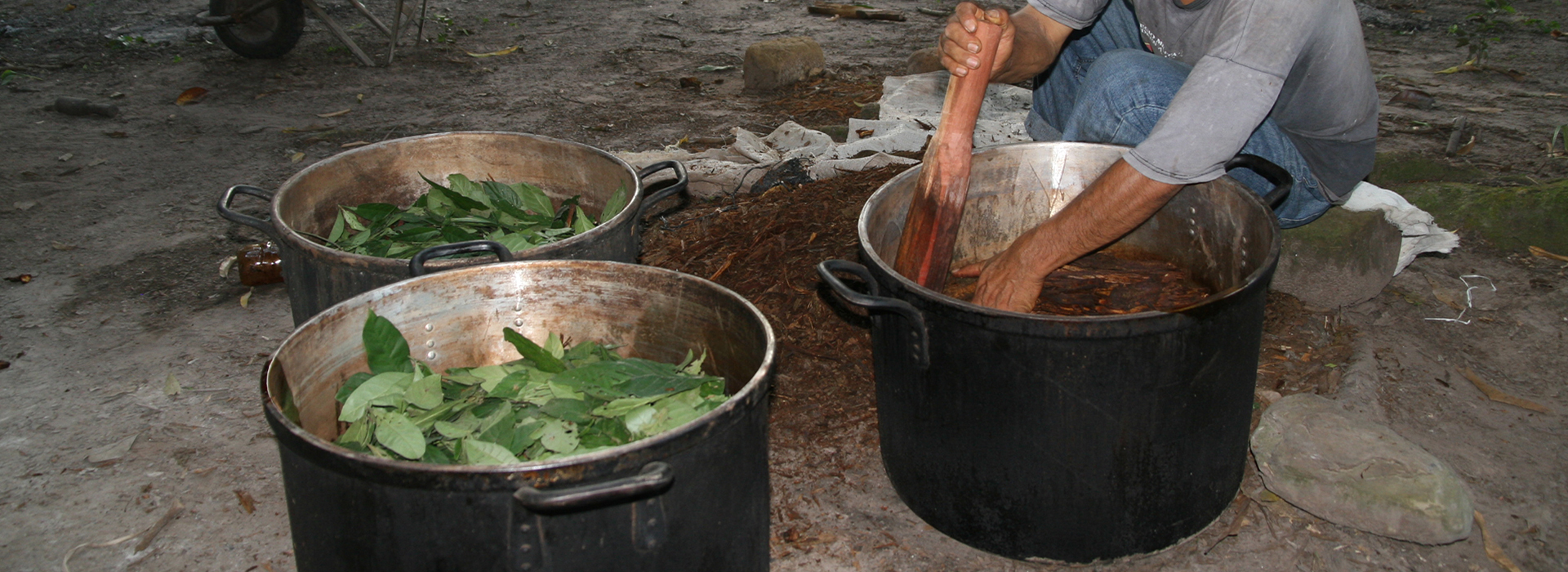A new scientific study has been published that aims to shed light on the understudied purging and emetic effect of the ayahuasca brew, reviewing the cultural relevance of emesis and purging in the context of traditional Amazonian medicines and accompanying this analysis with phytochemical and pharmacological data.
Ayahuasca: from local medicine to global phenomenon
Ayahuasca is a traditional psychoactive brew with a long history of medicinal and religious use in the Amazonian basin, and with promising pharmaceutical potential in modern biomedical context [1]. The word ayahuasca comes from the Quechua language and can be translated into "the vine of the soul" or "the vine of death"; this brew is also known by several other names such as, yage, hoasca or caapi.
Indigenous and mestizo people in South America have used ayahuasca for centuries, and the ceremony associated with its consumption has now become popular among a western audience [2]. In fact, for some decades the ayahuasca ritual has been used to treat drug addiction, as in the case of the Takiwasi Center [3], and more recently, it is gaining further attention also as a treatment for other mental health disorders, especially for depression and anxiety, and as a tool to help in grieving processes and dealing with traumatic memories (PTSD) [4]. A tendency to go from a local consumption limited to the Amazon basin to a global phenomenon is thus clearly observed; this is accompanied by continuous increase of scientific publications focused on this brew in recent years.
Despite the great emphasis on the widely known psychoactive effects of ayahuasca and its potential application in mental health disorders, the scientific community seems to pay less attention to its purgative and emetic properties, being the latter only scarcely mentioned and mainly considered as undesirable side effects. In fact, some researchers have come to propose a synthetic formula of ayahuasca called Pharmahuasca to precisely avoid the "disadvantages" of vomiting [5]. Nonetheless, within the traditional ritual use, such purgative and emetic effects are considered relevant for the overall efficacy of the ayahuasca medicine [6].
The review study carried out by researchers from the University of Chieti, Italy, and led by the scientific director of Takiwasi, Matteo Politi, has set the aim of precisely reviewing the cultural significance of these effects within the traditional and ceremonial use of ayahuasca, and to review the pharmacology of the main constituents of the brew for their potential application in gastro-intestinal health. The study “Beyond the Psychoactive Effects of Ayahuasca: Cultural and Pharmacological Relevance of Its Emetic and Purging Properties” [7], has recently been published in the academic journal Planta Medica. We analyze here some of its main results, complementing the information with some considerations based on the clinical experience of the Takiwasi Center.

Purge for the body and the spirit
The first point to take into account to highlight the importance of the emetic effects of ayahuasca is that, within the Amazonian vegetalista tradition, a rather common name for ayahuasca is, in fact, purga (purge), and the healer administering it, may be referred to as the “purguero”. Similarly, in the indigenous Amazonian Matsigenka language, ayahuasca is called kamarampi, which comes from the word “kamarank” (to vomit) and can thus be translated into “remedy for vomiting” [8].
A study carried out in the town of Chazuta, located on the banks of the Huallaga River in the upper Peruvian Amazon, shows that ayahuasca’s primary and original function in the Amazonian pharmacopeia was in fact for gastrointestinal health, as purgative plants are a popular way of dealing with parasitic infections [9]. Physical cleansing traditionally includes "stomach cleansing" from poor diet, excesses in food and drink. This concept is now applied by extension to other fields and participants in an ayahuasca ceremony can purge and release what are considered negative or toxic aspects of the modern lifestyle, such as pharmaceuticals, processed foods, drugs, environmental pollution, electromagnetic radiation, media, etc. Anthropologist Luis Eduardo Luna, in turn, points out that ayahuasca’s efficacy is related to its ability to produce visions, just as much to its ability to induce vomiting and diarrhea. So much that when it does not fulfil one of these two functions it is considered to be a bad medicine [10].
In various South American indigenous health cosmologies, the origin of illness is seen to be caused by harmful spirits or by the presence of objects or spirits trapped in the body of the person. Vomiting thus serves to expel intruding entities from the body, ridding it from illness [11]. In addition, this cleaning process is necessary to clean the interference induced by "bad energies" and thus be able to establish contact with plant spirits which become allies in healing [8]. The notion of purification of the body is central and determines good relations with the invisible world and non-humans. Therefore, the use of ayahuasca as a purge is not limited to healing purposes. Indigenous hunters, for example, may use emetic plants such as ayahuasca to cleanse from bad spirits in their body and, through its psychoactive effects, they may visit the spiritual world to negotiate that the hunt is successful.
Based on the learning received by the staff of the Takiwasi Center from master healers in the region, ayahuasca is also used specifically to purge the damage (sorcery) located in the stomach and that manifests itself with gastric discomfort ("pain in the pit of the stomach"), apart from its psychic and spiritual effects. In most cases this witchcraft is carried out by ingesting a preparation secretly introduced into the victim's food or drink. In this case, the healer gives a dose of ayahuasca to his patient, outside of the classic night ceremonies, and after about 20 minutes make him drink 2 liters of warm water that induce vomiting and allow to expel the ingested damage. This procedure does not seek to induce dizziness (although visions can occur in sensitive people, but they are milder and do not last) but only to purge.
Access to the well-known effect of mareación (visionary dizziness), caused by the ingestion of ayahuasca often includes a prior cleansing with nausea and vomiting. A psychological or spiritual blockage is lifted with the physical expulsion and allows access to the visions and teachings, "pedagogical" qualities of the plant that is therefore called "teacher". On the other hand, during dizziness, the patient can access key information or intense visions that saturate his/her assimilation capacity or confront him/her with painful experiences of his existence, leading to liberating vomiting. In this sense, vomiting also represents a protection against becoming aware of contents that exceed the patient's ability to integrate; in other words, it offers psycho-emotional overdose prevention. Vomiting in general, in this situation, reduces the effects of dizziness and allows access to a more peaceful phase and with positive and healing awareness of the limits reached. Sometimes the intensity of this process is assimilated to an experience of death-rebirth. It can be interpreted as a way to throw out the bad and retain the good.
Psychic and emotional blockages cleansing
Clinical experience in Takiwasi shows us that, on a psychological level, vomiting involves a voluntary opening of the subject to "give back" and acceptance to face "the evil" that he has inside. Unlike anal evacuation linked to sadistic and domineering connotations, oral elimination involves humility and submission with confidence towards the therapist and to be guided through him toward Life. In itself, it signals and manifests the desire to "bow down", to break the harshness ("hard nape village people", the Bible says facing the rebelliousness of the Jewish people) and to free oneself from the "devils" one has inside. The patient decides to "throw up" what he has incorrectly ingested, the physical, mental and spiritual foods he swallowed without having the ability to digest them, metabolize them. With the purification of the mouth is the verb that is purified, the word and therefore the thoughts. If life is considered as a perpetual movement, every act of retention constitutes a way of stopping the vital flow [12].
It becomes evident how many times, in a neurotic way, a person "wants" his own suffering, prefers to maintain it, since it is known and regular, instead of getting rid of it and explore other ways of living. Hold on to something corresponds to an act that has to do with "having" and blocks from "being". This retention constitutes in some way a spiritual transgression in the way that it is opposed to the flow of life, the vital energy, and to the basic trust which is an act of faith. It is then a matter of restoring what has been improperly retained, returning it. Dare to let go, to give up the non-acceptance of what constitutes our life. The purgative effect of ayahuasca leads us to this necessary abdication, to that beneficial surrender to what is greater than us . In this sense appears a breaking point for pride, vanity, self-sufficiency to go towards acceptance of what life gives us and recognition of our limitations, our poverty, our inner dirt, even shaming human misery [12]. That misery that appeals to the mercy of something that goes beyond us. It invites us to exist for “being” and not for “having”. It invites us to renounce to the spirit of revenge that always seeks a return, a compensation for what we consider has been unfair to us in life. It invites us to give up the pattern of feeling victims facing a life that would be "bad" and recognize that it is us who do not know how to accept the goodness of life because we are not given it as we want, the way we want, when we want. In short, it invites you to give up this childish ego that does not know how to surrender and, in its inflation and tyranny, demands that things be the way it wants. "Killing" this childish ego leads certain people to assimilate vomiting voluntarily to a kind of death that generates strong reluctance. That small death is equivalent to giving up this enormous claim to know what is good for oneself and what life is, and because of that blindness one does not see the greatness of what is beyond and cannot access the humble contemplation of the extraordinary mystery of the to be alive. The purge gives access to this understanding, not in an intellectual way, but thanks to the body inscription that is given through the vomit [12].
Indigenous Amazonian shamanism and the use of ayahuasca have been shaped through contact and exchange with nearby and foreign cultures across the centuries. Therefore, within the current neo-shamanic context, the meaning and act of vomiting and purging also becomes porous to adjustment. In fact, from a Western point of view, vomiting is generally seen as a by-product of the ayahuasca experience, a prerequisite “for the nobler visionary end”. As Beyer pointed out, vomiting is distressing to a westerner, who usually even considers it humiliating [13].
So far, Fotiou and Gearin produced the only study which gives centrality to the topic of purging related to ayahuasca intake, making the point that, in contemporary contexts, purging is not merely a physical act, but is dense with meaning and associated with what can be called a psychic purging. The experience of vomiting may certainly be reframed through a new psychological lens and a new understanding of healing [6]. For example, given the popular Western interest in shamanism for mental healing and personal development purposes, the difficulties encountered during the rituals are perceived as personal blockages. Under this approach, purging becomes a necessary process to expel, for example, emotions and states of being which put a strain on the person, feelings of emptiness or the weight of past traumatic events, including unresolved grieving processes.

In the new contexts of use of ayahuasca, vomiting and purging might be perceived as a required step to find one’s life path, process difficult emotions, contact the unconscious or “expiating immoral behavior” [14]. Purging provides a visible sign of healing and the notion of cleansing extends to physical and emotional but also spiritual levels. Another fact to highlight is that, through rituals with emetic plants, people can acquire a new perspective or awareness about the mutual relationship between the physical and spiritual world.
Vomiting also appears to hold a social valence within the context of healing. The very same act and sound of vomiting may diffuse across the social field of the ritual circle during a ceremony and influence other participants’ visions and experience.
Gut-brain relationship
The new scientific study produced by the University of Chieti also takes into account the role of the gut-brain relationship. The gut microbiota seems to have an influence in the development of various diseases of central nervous system, including motility and behavioral disorders, neurodegenerative disease and cerebrovascular accidents. Scientific studies have highlighted a direct correlation between the intestinal microbiota and the brain, establishing the existence of the so called gut microbiota–brain axis [15, 16]. Ayahuasca itself, with its alkaloids such as harmine and harmaline, could contribute to altering the general gut microbiota, although the relation of this effect on mental health is still far to be assessed [17].
Recently, anthropologists Fotiou and Gearing sought to create a dialogue between indigenous perspectives and studies that demonstrated how gut and brain share bi-directional flows of information, including stress and emotion [6]. Thus, the biological relation between the gut and the brain seems to echo with the understandings of traditional practitioners and cross cultural narratives of purging related to the expulsion of negative things, including emotions, from the body, indicating that these perspectives should not be dismissed as having a purely symbolic (virtual) valence, while they may actually have a correspondence at the level of clinical practice. Indeed, this latest review article seems to confirm, based on the phytochemical content of ayahuasca, its potential effect at the gastrointestinal level and its interconnection at the neuropsychological level.
Emesis and purging: problem or solution?
Within the modern biomedical approach, purging and emesis are usually considered more physiopathological conditions that require specific treatments rather than being considered therapeutic tools as happens in Amazonian traditions. In different traditional medicinal contexts, they are actually representing important detoxification strategies, by activating in various ways all the emunctories (sweating, diarrhea, salivation, etc.) often practiced in combination with the use of medicinal plants; this is the case for example of the famous pancha karma therapy belonging to the Ayurveda tradition in India, but also of laxative herbal treatments belonging to the traditional Chinese medicine or Japanese kampo. Several examples of purging practices belonging to the traditional Amazonian herbal medicine have been described, not only with plants but also with animal drugs such as kambó, and it is worth mentioning that a liquid preparation of Amazonian tobacco (Nicotiana rustica) is still used as an important purge [18]; in this sense a connection can be made with the tobacco enema which was also part of the western medical tradition. It may then be interesting to reflect on how in Western culture the gastric lavage is used only in the event of severe and acute poisoning, and not as a prevention tool, nor to "cure" chronic poisonings or of a nature other than those linked to the material level of the reality that surrounds us.
It seems therefore that emesis and purging are still laying on a subtle border between being considered problems or solutions. In this regard, it is of noteworthy interest to mention how emesis is a key protective reflex, involving multiple systems, including respiratory, gastrointestinal and abdominal muscles, and studies show that it serves also as a potential therapeutic option, especially towards food toxin ingestion and migraine attack [19]. On the other hand, the very practice of vomiting, as mentioned above, is an important aspect of traditional Amazonian medicine, where emetic plants are used for cleansing purposes not only to restore health but also to maintain it.

Conclusion: purges and visions are inseparable
The conclusion of the authors of this new study is then that the key factor that defines emesis and purging as a problem or a solution (and this also applies to the use of psychedelics in general) is the context of use, often related with the cultural context. To summarize, what emerges from the various study contexts analyzed, both indigenous and mestizo Amazonian, is that the function of ayahuasca-related purgative and emetic effects are closely linked, if not inseparable, from the visionary and psychoactive ones. This link seems fundamental even in the modern context of ayahuasca use: despite the fact that vomiting as a healing method is not relevant in the current Western culture, in contemporary neo-shamanic ayahuasca use purging, extended to the psychic, emotional and spiritual levels, is an essential and intrinsic aspect of its medicinal efficacy. A good purge is a good medicine.
Literature
[1] Frecska, E., Bokor, P., Winkelman, M. (2016). The therapeutic potentials of ayahuasca: Possible effects against various diseases of civilization, Frontiers in Pharmacology 7: 35.
[2] Luna, L.E. (2011). Indigenous and mestizo use of ayahuasca. An overview. In The Ethnopharmacology of Ayahuasca, Rafael Guimarães dos Santos ed., pp 1-21.
[3] Mabit, J. (2007). Ayahuasca in the treatment of addictions. In: T.B. Robert, M.J. Winkelman (Eds.), Psychedelic Medicine: New Evidence for Hallucinogenic Substances as Treatment, pp. 87–103.
[4] Inserra A. (2018). Hypothesis: The Psychedelic Ayahuasca Heals Traumatic Memories via a Sigma 1 Receptor-Mediated Epigenetic-Mnemonic Process. Frontiers in Pharmacology, 9, 330.
[5] Ott J. (1999). Pharmahuasca: human pharmacology of oral DMT plus harmine. Journal of Psychoactive Drugs, 31(2):171-7.
[6] Fotiou, E., Gearin, A.K. (2019). Purging and the body in the therapeutic use of ayahuasca, Social Science Medicine 239: 112532.
[7] Politi, M., Tresca, G., Menghini, L., Ferrante, C. (2021). Beyond the Psychoactive Effects of Ayahuasca: Cultural and Pharmacological Relevance of Its Emetic and Purging Properties. Planta Medica.
[8] Shepard, G.H. (1998). Psychoactive plants and ethnopsychiatric medicines of the matsigenka. Journal of Psychoactive Drugs, 30: 321–332.
[9] Sanz-Biset, J., Cañigueral, S. (2013). Plants as medicinal stressors, the case of depurative practices in Chazuta valley (Peruvian Amazonia). Journal of Ethnopharmacology, 145: 67–76.
[10] Luna, L.E. (1986). Vegetalismo: Shamanism among the mestizo population of the Peruvian Amazon. Almqvist & Wiksell International.
[11] De Feo, V. (2003). Ethnomedical field study in northern Peruvian Andes with particular reference to divination practices. Journal of Ethnopharmacology, 85: 243–256.
[12] Mabit, J. (2014). Ceremonia ritual de la yawar panga. Conferencia inicialmente presentada al VII Congreso Internacional de Medicina Tradicional y Folklórica, Mérida, México, diciembre 1993, revisada y aumentada. Aportes del Sr. Rony Rengifo Yon, terapeuta y del Dr. Julio Arce Hidalgo, profesor de Ingeniería Química de la UNAP, Iquitos, Perú. https://takiwasi.com/es/yawar-panga.php
[13] Beyer, S. (2009). Singing to the plants: A guide to mestizo shamanism in the upper Amazon. University of New Mexico Press, pp. 544.
[14] Labate, B.C. (2014). The internationalization of Peruvian vegetalismo. In Ayahuasca Shamanism in the Amazon and Beyond, Beatriz Caiuby Labate and Clancy Cavnar (eds.). Oxford, New York : Oxford University Press.
[15] Maiuolo, J. Gliozzi, M., Musolino, V., et al. (2021). The Contribution of Gut Microbiota–Brain Axis in the Development of Brain Disorders. Frontiers in Neuroscience 15: 616883.
[16] Strandwitz, P. (2018). Neurotransmitter modulation by the gut microbiota. Brain Research, 1693: 128–133.
[17] Ahmad A, Khan K, Sultana S, Siddiqui B, Begum S, Faizi S, Siddiqui S. (1992). Study of the in vitro antimicrobial activity of harmine, harmaline and their derivatives. Journal of Ethnopharmacology, 35: 289–294.
[18] Berlowitz, I., Torres, E.G., Walt, H., Wolf, U. Maake, C., Martin-Soelch, C. (2020). “Tobacco is the chief medicinal plant in my work”: Therapeutic uses of tobacco in Peruvian Amazonian medicine exemplified by the work of a maestro tabaquero. Frontiers in Pharmacology, 11: 1.
[19] Chai, D., Jiang, H., Li, Q. (2016). Induced vomiting : a therapeutic option. International Journal of Clinical Experimental Medicine, 9: 17098–17105.
1 In French, the word “rendre” refers both to the notion of restitution (to give back) as well as to that of surrender.
